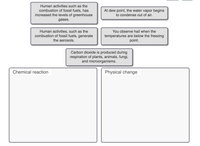
Chemistry: Matter and Change
1st Edition
ISBN: 9780078746376
Author: Dinah Zike, Laurel Dingrando, Nicholas Hainen, Cheryl Wistrom
Publisher: Glencoe/McGraw-Hill School Pub Co
expand_more
expand_more
format_list_bulleted
Concept explainers
Question

Transcribed Image Text:The diagram presented here is a classification exercise focused on distinguishing between chemical reactions and physical changes, based on given scenarios related to environmental science.
### Text Boxes:
1. **Human activities such as the combustion of fossil fuels, has increased the levels of greenhouse gases.**
- This statement can be classified under **Chemical reaction** due to the chemical changes involved in combustion processes that produce greenhouse gases like carbon dioxide.
2. **At dew point, the water vapor begins to condense out of air.**
- This is a **Physical change** as it involves a change of state from gas to liquid without altering the chemical composition of water.
3. **Human activities, such as the combustion of fossil fuels, generate the aerosols.**
- This is a result of a **Chemical reaction**, as aerosols are formed due to chemical processes linked with burning fuels.
4. **You observe hail when the temperatures are below the freezing point.**
- This is a **Physical change** because it involves the freezing of water droplets into ice, changing the state of matter without a chemical alteration.
5. **Carbon dioxide is produced during respiration of plants, animals, fungi, and microorganisms.**
- This is an example of a **Chemical reaction** as it involves the biochemical processes that convert oxygen and glucose to carbon dioxide and water during respiration.
### Categories:
- **Chemical Reaction:**
- Involves a change in chemical composition, resulting in new substances being formed, such as the production of greenhouse gases, aerosols, and processes in respiration.
- **Physical Change:**
- Involves changes in physical state or appearance without altering the chemical composition, such as condensation and hail formation.
Expert Solution
This question has been solved!
Explore an expertly crafted, step-by-step solution for a thorough understanding of key concepts.
This is a popular solution
Trending nowThis is a popular solution!
Step by stepSolved in 2 steps

Knowledge Booster
Learn more about
Need a deep-dive on the concept behind this application? Look no further. Learn more about this topic, chemistry and related others by exploring similar questions and additional content below.Similar questions
- 4.60 Why are fuel additives used?arrow_forwardA newspaper article states that biomass has actually been used as an energy source throughout human history. Do you agree or disagree with this statement? Defend your answer.arrow_forwardThe previous answer I was given was incorrect. Please be sure of your information. Read the question thoroughly and explain. Thank you.arrow_forward
- Describe two ways that people can change their habits and choices to reduce their personal greenhouse gas emissions. In each case, be clear about how the change reduces emissions.arrow_forwardWhy are multiple heating of the potassium chlorate necessary? Group of answer choices To make sure the reaction is complete when the mass reaches the required value. To make sure the reaction is complete when the mass does not change significantly. To avoid the potassium chlorate reacting with the atmosphere. To avoid an explosive reaction due to rapid heating.arrow_forwardthese are 2 separate questionsarrow_forward
- 20. Dissolving the salt potassium nitrate in water is an endothermic reaction. What would be observed if potassium nitrate was dissolved in water? a) The water would get very hot. b) The water would get colder. c) The salt would float to the top of the water. d) Bubbles of hydrogen gas would be produced.arrow_forwardPolychlorinated biphenyl (PCBs) are environmental contaminants composed of carbon, hydrogen, and chlorine atoms. A news report states that a new method of disposal of PCBs converts them completely to carbon dioxide and water. The necessary oxygen atoms come from the oxygen in the air. Do you think that this method will work? Please explain.arrow_forwardDescribe how the use of fossil fuels ties to global warming. Give three specific examples of cause and effect.arrow_forward
arrow_back_ios
SEE MORE QUESTIONS
arrow_forward_ios
Recommended textbooks for you
- Chemistry: Matter and ChangeChemistryISBN:9780078746376Author:Dinah Zike, Laurel Dingrando, Nicholas Hainen, Cheryl WistromPublisher:Glencoe/McGraw-Hill School Pub Co
 World of ChemistryChemistryISBN:9780618562763Author:Steven S. ZumdahlPublisher:Houghton Mifflin College Div
World of ChemistryChemistryISBN:9780618562763Author:Steven S. ZumdahlPublisher:Houghton Mifflin College Div
 Chemistry for Today: General, Organic, and Bioche...ChemistryISBN:9781305960060Author:Spencer L. Seager, Michael R. Slabaugh, Maren S. HansenPublisher:Cengage Learning
Chemistry for Today: General, Organic, and Bioche...ChemistryISBN:9781305960060Author:Spencer L. Seager, Michael R. Slabaugh, Maren S. HansenPublisher:Cengage Learning Chemistry for Engineering StudentsChemistryISBN:9781337398909Author:Lawrence S. Brown, Tom HolmePublisher:Cengage Learning
Chemistry for Engineering StudentsChemistryISBN:9781337398909Author:Lawrence S. Brown, Tom HolmePublisher:Cengage Learning Chemistry: The Molecular ScienceChemistryISBN:9781285199047Author:John W. Moore, Conrad L. StanitskiPublisher:Cengage Learning
Chemistry: The Molecular ScienceChemistryISBN:9781285199047Author:John W. Moore, Conrad L. StanitskiPublisher:Cengage Learning

Chemistry: Matter and Change
Chemistry
ISBN:9780078746376
Author:Dinah Zike, Laurel Dingrando, Nicholas Hainen, Cheryl Wistrom
Publisher:Glencoe/McGraw-Hill School Pub Co

World of Chemistry
Chemistry
ISBN:9780618562763
Author:Steven S. Zumdahl
Publisher:Houghton Mifflin College Div


Chemistry for Today: General, Organic, and Bioche...
Chemistry
ISBN:9781305960060
Author:Spencer L. Seager, Michael R. Slabaugh, Maren S. Hansen
Publisher:Cengage Learning

Chemistry for Engineering Students
Chemistry
ISBN:9781337398909
Author:Lawrence S. Brown, Tom Holme
Publisher:Cengage Learning

Chemistry: The Molecular Science
Chemistry
ISBN:9781285199047
Author:John W. Moore, Conrad L. Stanitski
Publisher:Cengage Learning